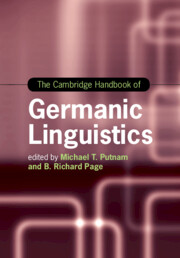Book contents
- The Cambridge Handbook of Germanic Linguistics
- Cambridge Handbooks in Language and Linguistics
- The Cambridge Handbook of Germanic Linguistics
- Copyright page
- Contents
- Figures
- Maps
- Tables
- Contributors
- Acknowledgments
- Germanic Languages
- Part I Phonology
- Part II Morphology and Agreement Systems
- Part III Syntax
- Chapter 15 VO-/OV-Base Ordering
- Chapter 16 The Placement of Finite Verbs
- Chapter 17 Germanic Infinitives
- Chapter 18 The Unification of Object Shift and Object Scrambling
- Chapter 19 Unbounded Dependency Constructions in Germanic
- Chapter 20 The Voice Domain in Germanic
- Chapter 21 Binding
- Chapter 22 Verbal Particles, Results, and Directed Motion
- Chapter 23 Structure of Noun (NP) and Determiner Phrases (DP)
- Part IV Semantics and Pragmatics
- Part V Language Contact and Nonstandard Varieties
- Index
- References
Chapter 17 - Germanic Infinitives
from Part III - Syntax
Published online by Cambridge University Press: 31 March 2020
- The Cambridge Handbook of Germanic Linguistics
- Cambridge Handbooks in Language and Linguistics
- The Cambridge Handbook of Germanic Linguistics
- Copyright page
- Contents
- Figures
- Maps
- Tables
- Contributors
- Acknowledgments
- Germanic Languages
- Part I Phonology
- Part II Morphology and Agreement Systems
- Part III Syntax
- Chapter 15 VO-/OV-Base Ordering
- Chapter 16 The Placement of Finite Verbs
- Chapter 17 Germanic Infinitives
- Chapter 18 The Unification of Object Shift and Object Scrambling
- Chapter 19 Unbounded Dependency Constructions in Germanic
- Chapter 20 The Voice Domain in Germanic
- Chapter 21 Binding
- Chapter 22 Verbal Particles, Results, and Directed Motion
- Chapter 23 Structure of Noun (NP) and Determiner Phrases (DP)
- Part IV Semantics and Pragmatics
- Part V Language Contact and Nonstandard Varieties
- Index
- References
Summary
Infinitival constructions have been central in Germanic for several reasons and they have been at the core of theory-building syntactic research. This paper presents an overview of two research areas— exceptional case marking (ECM) and restructuring. While in-depth discussions of these rich topics are not possible, we aim to highlight some of the major discoveries and remaining puzzles. The first part of the chapter discusses the distinction between control and ECM and provides an overview of the distribution of ECM in six Germanic languages (English, Icelandic, Swedish, Norwegian, Dutch, and German). The second part of the paper summarizes phenomena falling under the rubric of restructuring. Although the literature on restructuring has focused predominantly on German and Dutch, phenomena showing sensitivity to restructuring have also been observed in the Mainland Scandinavian languages. Finally, in the last part we combine the observations regarding ECM and restructuring and suggest a possible connection.
Keywords
- Type
- Chapter
- Information
- The Cambridge Handbook of Germanic Linguistics , pp. 389 - 412Publisher: Cambridge University PressPrint publication year: 2020
References
- 1
- Cited by



